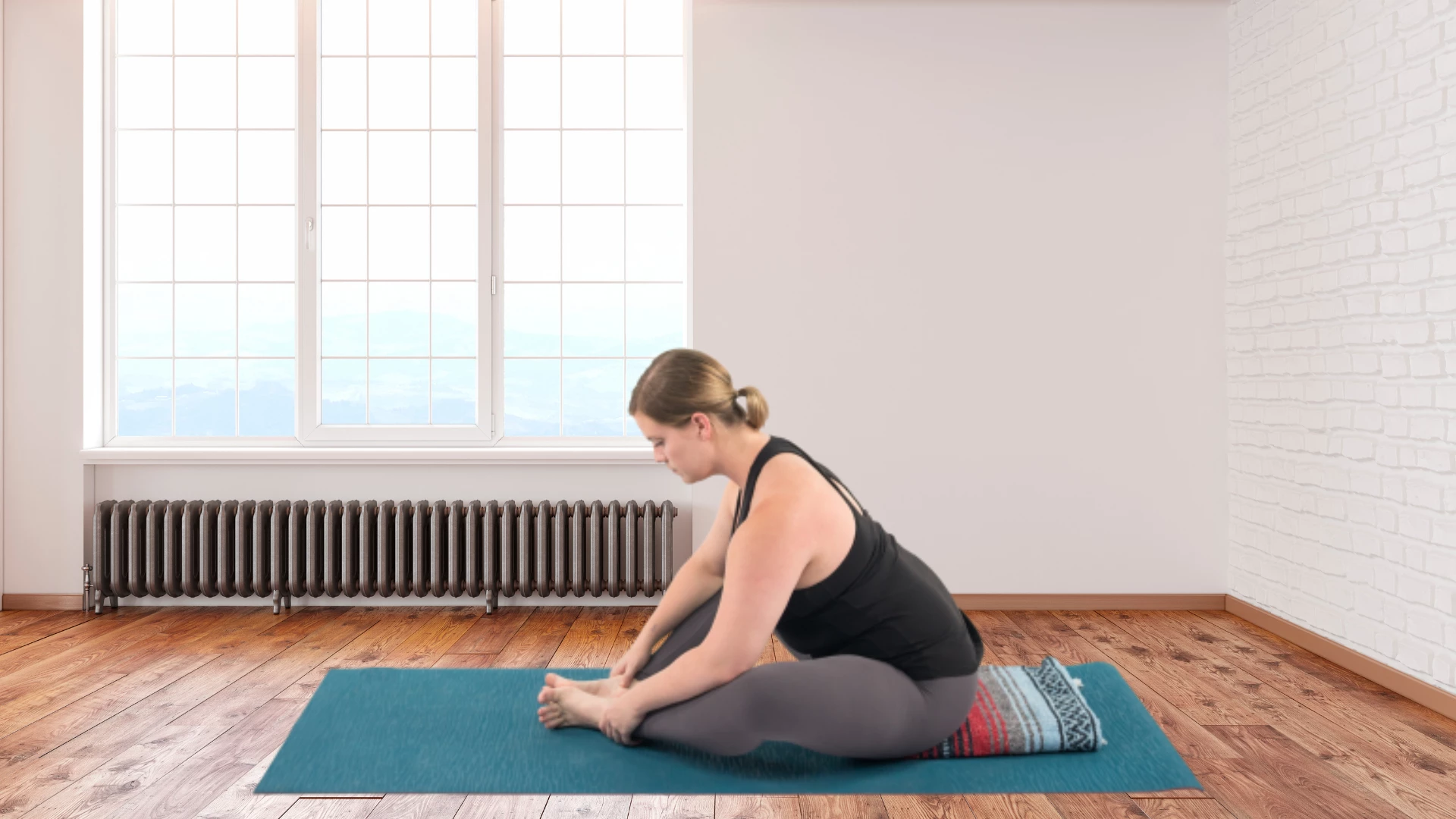7 Common Misconceptions About Yin Yoga

Article At A Glance
What’s keeping you from practicing Yin Yoga? This article debunks the top 7 most common misconceptions about the practice. Dive into this article to debunk these myths!
As a Yin Yoga practitioner and teacher trainer, I often hear some of the unfavorable things that people say about Yin Yoga. And honestly, I don’t blame them. I raised many of the same critiques when I first encountered the practice. I thought Yin Yoga looked sloppy, poorly aligned, and dangerous. But, having practiced, studied, and taught the physiological, energetic, and meditative dimensions of Yin Yoga for over 20 years, I now have better responses to my former self’s critiques, and I hope they support your practice and understanding of Yin Yoga. Here are seven common misconceptions about Yin Yoga.
1. Yin Yoga is Just Restorative Yoga Under a Different Name.

Yin Yoga might look like a stylized version of Restorative Yoga, but the internal experience is quite different. And the internal difference between the two boils down to whether you are generating or minimizing the experience of stress in the body. In Yin Yoga, we’re intending to bring an appropriate degree of mild stress to our target areas and we might strategically use a prop or props as a way of increasing or decreasing the appropriateness of that stress. In Restorative Yoga, generally speaking, props are used to minimize stresses on the body, facilitating a different kind of restorative dynamic.
In Yin Yoga, while we let our bodies steep at the edge of mild and moderate stress, sensations can become slightly bitter and achy, and our chattering minds may proliferate a parade of uninvited commentary and concern. And when things get bitter, in some ways, that’s when the transformational magic of Yin Yoga kicks in. By acknowledging and softening around these challenges, we’re able to shift from a mode of knee-jerk reactivity to a mode of skillful relationship.
With a regular Yin Yoga practice, over time, we cultivate a compassionate awareness with which we can meet our inner and outer worlds. But even though Yin Yoga might at times look like Restorative Yoga, the intentions and experiences of these practices are quite distinct.
2. Yin Yoga May Overstretch and Destabilize Joints.
Often when people hear about the idea of safely stressing joints in Yin Yoga, people unfamiliar with the principles of the practice will raise well-intentioned concerns about overstretching. These misconceptions about Yin Yoga seem to boil down to conflating the safe “stress” we place on joints in Yin Yoga with the overstretching and destabilization of a joint that occurs with trauma. And this conflation is really between the word “stress” with the word “stretch.” Stress is the force applied to something, in this case, our joint tissue. Stretch is the subsequent lengthening that occurs due to the stress placed on that tissue. But here’s the important takeaway: not all stresses cause stretches.
In Yin Yoga, the physical intention is to safely and moderately stress our connective tissues to promote their health. Great care is given to observing and differentiating between appropriate sensations and sensations to be avoided. When practiced intelligently, Yin Yoga functions as a wonderful complementary exercise for the dense connective tissues of the body. But like any form of exercise, people may override alarm signals of pain and end up injured. As always, intention and awareness are critical keys to safe practice, no matter the style.
3. Yin Yoga is Dangerous Because it Encourages Collapsing into One’s Joints.

All forms of physical yoga apply various forces to our bodies. Those forces are often described as tensile, compressive, and sheering forces. I’ve found that people tend to think of “compression” (ie. compressive forces) as flat-out bad. Yoga teachers of many styles might even say, “Don’t compress your lower back”, “Don’t hang in your lower back”, or “Don’t dump in your lower back.” But to maintain their health, all tissues require appropriate dosages of stress, without stress or exercise, tissues atrophy.
Yin Yoga encourages strategically positive stress on tissues, which is sometimes compressive, as in passive Yin Yoga backbends. Learning to practice Yin Yoga well involves learning how to play one’s edge of appropriate stress. Too much or too little stress is problematic. But in Yin Yoga, we seek the Goldilocks Zone of “just right” sensation, sending the “appropriate stress” to the tissues for regaining or maintaining their health and vitality.
4. In Yin Yoga, Alignment Doesn’t Matter. People seem to Align Themselves However They Want.

For years, I was taught that alignment in yoga meant that every student’s body must try to look like the teacher’s body in any given pose. Over the years, I’ve learned to view this approach to alignment as an aesthetically-based approach. The “correctness” of alignment in an aesthetic approach is primarily determined by how closely the posture looked like a visual ideal (think “straight” knees, “parallel” thighs, “90-degree” knees, “square” hips).
In contrast, Yin Yoga teachers tend to speak about “functional” alignment—approaching alignment as a process of helping each unique student find their own optimal form for aligning with the posture’s intention.
As a yoga teacher, I feel indebted to Paul Grilley and Bernie Clark for their painstaking work in shedding light on the truth and implications of human skeletal variation. Given the tremendous variations in the shape, length, orientation, and curvature of bones between different bodies, functionally-aligned Yin Yoga teachers guide students to experience the functional intention of a posture, usually phrased as “stimulating a target area.”
But because of this functional and, therefore, non-aesthetic approach to alignment, Yin Yoga teachers don’t shower students with absolute rules of aligning the body to look a certain way. Someone new to Yin Yoga might erroneously think, “Aha!! Look around. Everyone seems to be doing whatever they want. Clearly, alignment doesn’t matter in Yin Yoga.” This is one of the common misconceptions about Yin Yoga. Of course, alignment absolutely does matter. There’s just no one-size-fits-all absolute alignment that will universally work for everyone.
Functionally aligned Yin Yoga teachers understand the fact that everyone’s body is unique, especially at the skeletal level. Because of skeletal variations (differences in shapes, lengths, orientations, angles, and curvatures of bones)—between bodies and within bodies—Yin Yoga encourages students to modify poses to honor their unique bodies and to find an alignment that truly aligns themselves within the posture’s intention. As we often say in Yin Yoga, “Modifications aren’t the exception; they’re the norm.”
5. Yin Yoga is for People Deficient in Energy, i.e., Lazy People.

People often think that being enthusiastic about Yin Yoga means you’re “too lazy” to do a stronger flow class or that you’re somehow fooling yourself that Yin Yoga qualifies as “exercise.” First, Yin Yoga is not a standalone or complete practice. Yin Yoga, at a purely physical level, is a valuable supplemental practice to active forms of exercise. But no Yin Yoga teacher worth their Qi is going to advocate Yin Yoga as the sole path to physical fitness.
As an acupuncturist, I consider Yin Yoga to be a powerful practice for cultivating and circulating one’s Qi (vital energy) so that by virtue of this inner cultivation, one’s Yang expression of life flourishes with vitality. Many Ashtangis love to do Yin in the evening before bed to balance their active practice. They also describe feeling “more fluid and intuitively graceful” in their stronger vinyasa-based practice.
Crossfitters have their own version of Yin Yoga called ROM-WOD (Range of Motion Workout of the Day), and they find that their bodies recover faster and are less inflamed because of incorporating the principles of Yin Yoga. Avid runners also love Yin Yoga for similar reasons. From an acupuncture perspective, Yin Yoga embodies the principle: “Nourishing Yin, Harmonizing Yang.”
6. I’m Someone Who Needs to Move, So Yin Yoga isn’t My Cup of Tea.

Because Yin Yoga tends to be quiet and still, one of the common misconceptions about the practice is that you have to already be still in order to practice. Not true. If anything, Yin Yoga is a practice within which we can explore a new relationship with our scattered, restless selves. Through the gentle act of intending to be present, intending to be mindful, and intending to be compassionate, we can start to soften and transform the restless agitations of our anxious hearts while cultivating a recognition of our innate capacities for presence, receptivity, and stillness.
By nurturing these capacities in a Yin Yoga practice, practitioners often describe how much more equanimous they feel. And this is the bittersweet truth of Yin Yoga. By learning to tolerate some of the bitter dynamics in body and mind that arise in Yin Yoga, one may begin to awaken new skills of perception and relationship that promote deeper connection, understanding, and empathy. All beings with bodies need to skillfully move and skillfully rest. From a Daoist perspective, skillfully balancing Yin and Yang manifests the Way.
7. You Shouldn’t Practice Yin Yoga if You’re Pregnant.

During pregnancy, the hormone relaxin is produced, relaxing ligaments to prepare the birth canal for delivery. In turn, pregnant women often think that doing Yin Yoga during pregnancy will overstretch their ligaments. But this concern could apply to all types of yoga during pregnancy, not just Yin Yoga. Acknowledging these hormonal and physical changes during pregnancy, in Yin Yoga, we cue mothers-to-be not to go past their normal ranges of motion, and to not increase their ranges of motion.
And like any intelligent yoga practice, Yin Yoga offers various modifications to accommodate a growing baby. For example no deep twisting or compression on the abdomen. All told many expectant mothers find that the gentle stimulation of Yin Yoga helps release aches and tensions and smooths their energy flow.
In clearing up these common misconceptions about Yin Yoga, I hope you will discover and enjoy the Yin side of your yoga practice.
Also, read...
Lateral Love: A Gentle Yin Yoga Sequence to Lengthen the Side Body
Restorative Yoga: A 75-Minute Sequence to Soothe the Nervous System and Initiate the Relaxation Response
Trauma-Informed Yoga: 12 Keys to Teaching A Safe, Healing Class
Related courses
Breath as Medicine: Yogic Breathing for Vital Aging
Yoga and Myofascial Release: Releasing Chronic Tension with the Bodymind Ballwork Method

Josh Summers, acupuncturist, Yin Yoga teacher, and lifelong meditator, shares a passion for the principles of Chinese Medicine, Buddhist meditation, Yin Yoga, and holistic healing. Josh lives in rural Maine with his partner, Terry Cockburn, where they co-lead the River Bird Sangha – an online practice community for Yin Yoga, Qi Gong, and meditation. For a FREE copy of Josh’s ebook The What, Why, and How of Yin Yoga, the podcast Everyday Sublime, or their Yin Yoga School and practice sangha, please visit Josh at www.joshsummers.net.



